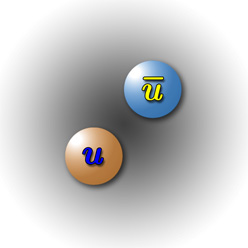Pimesons
The positive pimeson,
![]() +,
is the lightest particle in the group of medium heavy particles, the mesons. It consists of a quark (u)
and the antiquark (anti-d).
+,
is the lightest particle in the group of medium heavy particles, the mesons. It consists of a quark (u)
and the antiquark (anti-d).
![]() +
is instable and decays into µ+, which in turn decays into a positron
e+; neutrinos are also created. In these decays it is the quarks that
are transformed. The charges of the quarks in
+
is instable and decays into µ+, which in turn decays into a positron
e+; neutrinos are also created. In these decays it is the quarks that
are transformed. The charges of the quarks in
![]() +
is +2/3 (u) and +1/3 (anti-d), which gives the total charge +1.
+
is +2/3 (u) and +1/3 (anti-d), which gives the total charge +1.
The neutral pimeson,
![]() 0,
consists of the quark pairs (u, anti-u) or (d, anti-d). Both combinations give the total charge 0.
0,
consists of the quark pairs (u, anti-u) or (d, anti-d). Both combinations give the total charge 0.
![]() 0
decays when its quarks annihilates each other; photons are created in such a decay.
0
decays when its quarks annihilates each other; photons are created in such a decay.

Finally, the negative pimeson,
![]() -,
consists of the quark pair (anti-u, d). It is easy to see how the charges of the quarks combine into -1.
-,
consists of the quark pair (anti-u, d). It is easy to see how the charges of the quarks combine into -1.
![]() -
decays through quark transformation into µ-, which decays into an e-; neutrinos
are also created in this process.
-
decays through quark transformation into µ-, which decays into an e-; neutrinos
are also created in this process.
The pimesons are created "naturally" in the cosmic radiation.